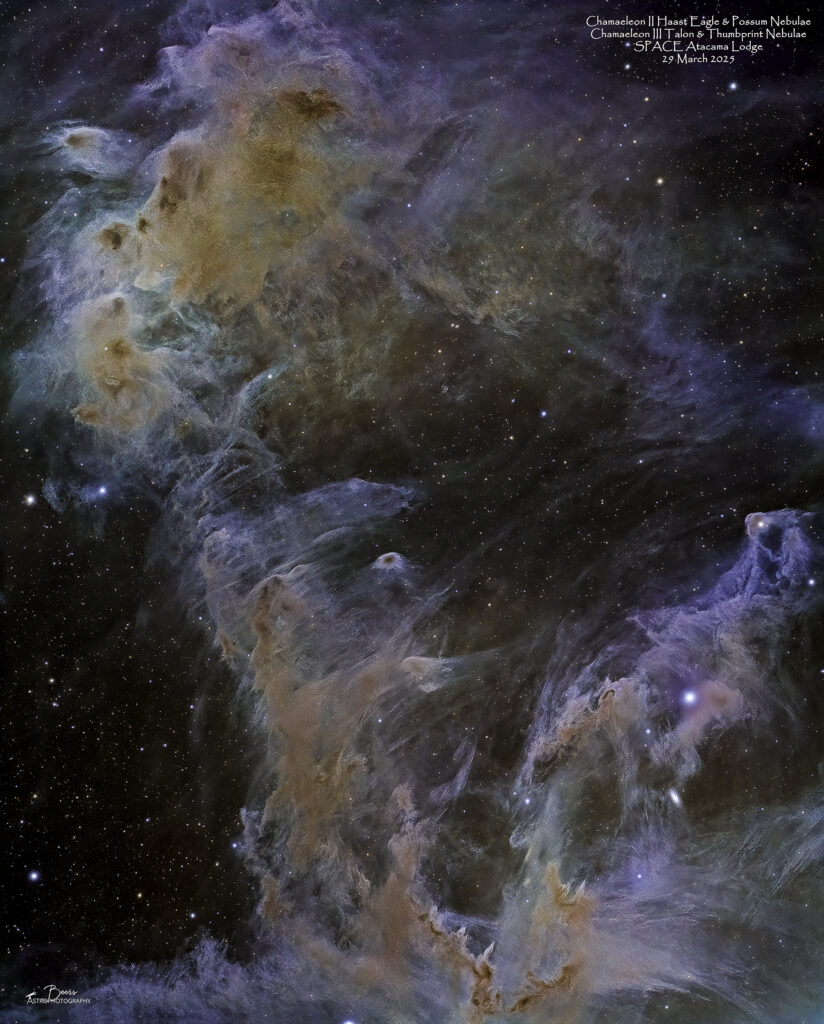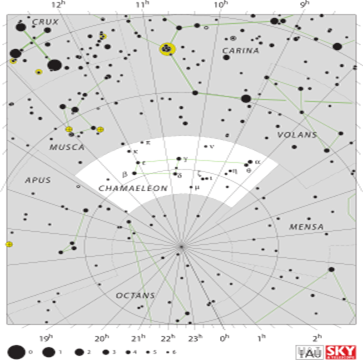
Fun facts
Chamaeleon constellation: Chamaeleon is a small constellation in the deep southern sky. It is named after the Chamaeleon, a kind of lizard. It was first defined in the 16th century.

STARS: There are four bright stars in Chamaeleon that form a compact diamond-shape approximately 10 degrees from the south celestial pole and about 15 degrees south of Acrux, along the axis formed by Acrux and Gamma Crucis. Alpha Chamaeleontis is a white-hued star of magnitude 4.1, 63 light-years from Earth. Beta Chamaeleontis is a blue-white hued star of magnitude 4.2, 271 light-years from Earth. Gamma Chamaeleontis is a red-hued giant star of magnitude 4.1, 413 light-years from Earth. The other bright star in Chamaeleon is Delta Chamaeleontis, a wide double star. The brighter star is Delta2 Chamaeleontis, a blue-hued star of magnitude 4.4. Delta1 Chamaeleontis, the dimmer component, is an orange-hued giant star of magnitude 5.5. They both lie about 350 light years away.
DSOs: The constellation contains several molecular clouds (the Chamaeleon dark clouds) that are forming low-mass T Tauri stars. The cloud complex lies some 400 to 600 light years from Earth and contains tens of thousands of solar masses of gas and dust. The most prominent cluster of T Tauri stars and young B-type stars are in the Chamaeleon I cloud, and are associated with the reflection nebula IC 2631. Chamaeleon contains one planetary nebula, NGC 3195, which is fairly faint. It appears in a telescope at about the same apparent size as Jupiter. {From: https://en.wikipedia.org/wiki/Chamaeleon}
Chamaeleon II – Haast Eagle and Possum Nebulae: In Eastern Chamaeleon, south of the constellation Musca, we find Cha II. The nebula complex is riddled with Bok Globules like dark nebulae that seem to have starless cores at this time, but these could eventually ignite at a later stage. These non-catalogued dark nebulae are extremely difficult to observe even with the largest amateur apertures.
Photographically the dark objects contrast nicely with the steely grey dust clouds in this area. From these scattered blobs emerges another tale of predators and prey. At the northern-most end of this nebula group lurks the shadowy silhouette of a bird of prey. We have bestowed the descriptive name of the Haast Eagle on this bird. The Haast Eagle, now extinct, was the largest eagle that ever lived. Its wingspan was similar to modern golden eagles but it was body size that made this bird so great.
Why did we choose the Haast Eagle? Not just because of its great size but also because of its prey, the largest bird that ever lived, the Moa! It just so happens that a few degrees south-west, surrounding the star Beta Chamaeleontis, we have a nebula that strongly resembles the ancient Moa (imaged on Thursday, 27Mar2025). These two nebulae sit in an area of about ten square degrees.
South-east of the Haast Eagle we find a small bunch of rounded dark spots, some oval and other pointed at one end. Not one of the most popular marsupials in southern hemisphere forest, we have nonetheless immortalized the Possum, seen here climbing down a tree, in the night sky.
Chamaeleon III: Talon and Thumbprint Nebulae: In the northern region of Cha III we can find the bright/dark nebula the Thumbprint. The Thumbprint Nebula was first coined by David Malin back in the late 1970’s. Visible in large telescopes it still takes a very transparent sky to show this small object at all. The Thumbprint covers 5.5’ x 3.3’.
Looking at the wider view and considering the nearby Haast Eagle, we have dubbed this stream of streaky dust, the Talon. The shaft of the talon stretches up from the south and appears to be reaching to pluck the Thumbprint out of the sky!
The condensations of Cha III have the lowest density of any in the region and are not expected to produce stars. The area is covered with long filaments and the major condensations often consist of clumps of material loosely bound and held mainly by electromagnetism along the filament lines. These nebulae lie approximately 1600 light years from the Sun. {From: Imaging the Southern Sky; Stephen Chadwick and Ian Cooper; pp. 269-271}
Distance: 1600 light years
Apparent dimensions: (Field size of Chadwick&Cooper images)
Haast Eagle and Possum Nebulae: 2.1° x 1.5°
Thumbprint: 5.5’ x 3.3’
Talon and Thumbprint Nebulae: 1.7° x 1.4°
Constellation: Chamaeleon
Other Designations: Chamaeleon Region
{From: Imaging the Southern Sky; Stephen Chadwick and Ian Cooper; pp. 269-274}
Capture & Processing Notes
This was the image captured on Saturday night before Jan and Dave’s departure for Patagonia and a drive to the Calama airport early in the morning to drop them off. I went back to the Chamaeleon constellation targets because they are up all night, with a single meridian flip in the early morning hours (in this case 01:48), then didn’t set until after astronomical twilight began (i.e., I could let the sequence run while we were gone on the drive to the airport).
Captured as a 2-tile mosaic with the Haast Eagle & Possum and Thumbprint & Talon together in the mosaic. Again, as with the Rippling Flames & Moa 2-tile mosaic, I could switch between tiles and do the meridian flip in a single step. Not only was this important from the perspective of letting the sequence run while we were away, but it minimized the number of wake-ups during the night – the night following the 6+ hour polar alignment adventure (?) on Friday night when I got virtually no sleep because I was so frozen that when I did finally get to bed (~0300), I couldn’t sleep.
I conducted the RST-135E hand controller actions before dark (including ensuring I had the Southern Hemisphere parking location selected and stored in the mount’s firmware (spoiler alert – it STILL parked facing to the west every time!).
When it got dark enough (I thought) to start the polar alignment – I learned one more lesson about polar aligning in the Southern Hemisphere. Unlike our lovely bright Polaris, that you can polar align to during civil twilight, to align with Sigma Octantis (σ Oct) or Polaris Australis one must wait until astronomical twilight has fully set in (i.e., it’s dark, dark) so that the gain and exposure time on the Polemaster software can be turned to almost the maximum (300ms, 90 gain) so that you can see the stars making up the trapezium with σ Oct clearly on the screen. Once I was “patient enough” (?) to wait that long (until about 20:30CDT), I found the stars making up the Southern Hemisphere Polemaster template and successfully completed the polar alignment! I disassembled the Polemaster camera, stowed it, and connected the cabling; getting the SGP sequence actions started at 20:48CDT. The rest of the sequence start-up went well with the first subframe capture starting at 20:57CDT…and went inside to join Jan and Dave for a glass of wine to toast their next leg of their adventure and the fun that we’d had together on this leg.
At 01:48, I got up to do the meridian flip and switch to tile#2. The sequence had completed 55 subframes on tile#1. I was satisfied with that amount of data (on the Haast Eagle & Possum) so I executed the plan of flipping and switching by ending the sequence, disconnecting equipment, recycling power, deselecting tile#1, and restarting the sequence on tile#2 for the rest of the night.
I got back from the run to the airport at 07:44CDT and completed the calibration frames, packed up the cabling, and wrapped SC in her daytime garb (Danita’s covers and a white tablecloth to protect her from the Atacama desert sun.
Sequence Plan (29Mar2025): Gain 158, Offset 30, Temp 0°C;
Tile#1: 55x5min. Captured 29Mar2025, 20:57CDT – 30Mar2025, 01:55CDT. Total: 4:35hrs.
Tile#2: 50x5min. Captured 30Mar2025, 02:08CDT – 06:40CDT. Total: 4:10hrs.
Mosaic: 105x5min. Captured 29Mar2025, 20:57CDT – 30Mar2025, 06:40CDT. Total: 8:45hrs.
Processing summary: Captured in SGP, stacked tiles and then created mosaic in APP (Adaptive Airy), star removal with Starnet++, processing with LR/PS
Equipment
Equipment: All equipment controlled by HP Probook (DSO CTRL1) running Sequence Generator Pro v4.4.0.1441.
- Imaging (ASI2400-SC): ZWO ASI2400MC imaging camera; (Southern Cross) Askar FRA600 108mm f/5.6 Quintuplet Petzval Flat-Field Astrograph
- Autofocuser: ZWO EAF Electronic Automatic Focuser – Standard (EAF-5V-STD)
- Mount: Rainbow Astro RST-135E (controlled by iHubo ASCOM driver)
- Polar alignment: QHYCCD camera (controlled by Polemaster for polar alignment)
- Autoguiding: Orion 60mm Multi-Use Guide Scope with Orion StarShoot AutoGuider Pro Mono Astrophotography Camera (controlled by PHD2)
Summary
Captured: 29Mar2025, 20:57CDT – 30Mar2025, 06:40CDT. Total: 8:45hrs
Shooting location: San Pedro de Atacama Celestial Explorations (SPACE) Atacama Lodge, Chile
Equipment: Southern Cross on Rainbow Astro RST-135E
Processing summary: Captured in SGP, stacked tiles and then mosaiced in APP (Adaptive Airy), star removal with Starnet++, processing with LR/PS
